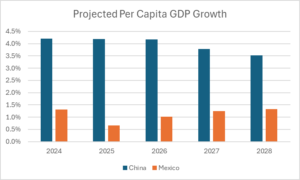Article • Dean Baker’s Beat the Press
Fact-based, data-driven research and analysis to advance democratic debate on vital issues shaping people’s lives.
Center for Economic and Policy Research
1611 Connecticut Ave. NW
Suite 400
Washington, DC 20009
Tel: 202-293-5380
Fax: 202-588-1356
https://cepr.net
There have been lots of reports in the media about China’s economic problems in recent months. Most of these pieces imply that it is facing some imminent disaster.
I will claim no special expertise on China, and it certainly looks like its government is pursuing some seriously wrongheaded policies, but it’s pretty difficult to see the disaster story in any publicly available data.
At the most basic level, most projections show its economy continuing to grow at a very healthy pace for the foreseeable future. Nonetheless, the coverage is almost exclusively negative.
For example, this New York Times piece noted China’s projection for 5.0 percent GDP growth in 2024 with the headline “Xi Sticks to His Vision for China’s Rise Even as Growth Slows.” China’s growth projections, as well as its official statistics, should be taken with a grain of salt. Nonetheless, few doubt that the picture shown by government data, of an extremely rapidly growing economy over the last four and half decades, is basically right.
But suppose we don’t want to take China’s projections for 2024 and instead turn to the I.M.F. as a more neutral source. The most recent projections from the I.M.F. show China’s economy growing 4.2 percent in 2024. Its growth is projected to remain above 4.0 percent for the following two years, and then fall somewhat below 4.0 percent for the last two years of its projection period.
Is this an economy in crisis? Well, it is undoubtedly slower than the near double-digit growth rates its economy chalked up for much of the period between 1980 and 2020, but it hardly seems like a crisis.
To see this point, we can compare the projected growth for China with the projected growth over this period for Mexico, a country with a nearly identical level of per capita income. This is shown below.

Source: International Monetary Fund.
As can be seen, Mexico is projected to have per capita income growth over this period averaging just over 1.0 percent annually, less than a third of China’s pace. (I have used per capita GDP to adjust for the fact that Mexico still has a growing population whereas China’s is declining slightly. Per capita GDP is a better gauge of living standards.) If we are to believe that China’s economy is facing some sort of crisis, then what do we think about an economy that is growing at less than a third of its pace?
It is also worth noting that, by this purchasing power parity measure, China’s economy is already considerably larger than the U.S. economy. It was 22.0 percent larger last year (24.0 percent including Hong Kong.) With the more rapid projected growth rate, it will be 34.0 percent larger by 2028.
This gap is worth noting when thinking about how best to deal with China. Those who think we can spend the country into the ground with a major military buildup need to check their arithmetic. (The Soviet economy peaked at roughly 60 percent of the size of the U.S. economy.)
The U.S. has differences with China in many areas, but both countries will fare much better if they look for areas for cooperation, like healthcare and climate, rather than confrontation. President Biden seemed to acknowledge this in his State of the Union address. It will be good if he follows through.